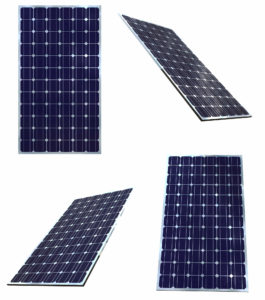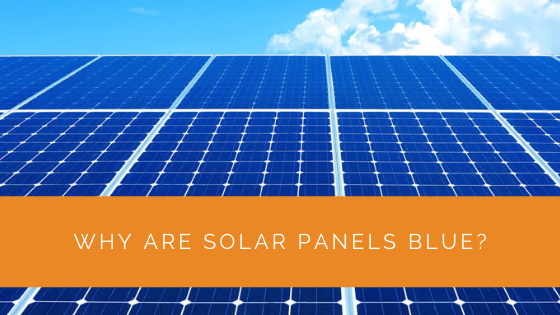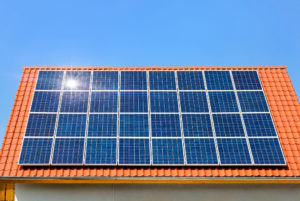If you’ve ever driven through residential neighborhoods, you must have noticed those blue rooftops. Wondering what these blue rooftops are? You guessed it right! They are the blue solar panels that are extremely common these days.
Even though there are many black solar panels available in the market, blue solar panels still remain the ones that people most use. The most obvious question that must come to your mind must be – why are solar panels blue?
The difference in the color of solar panels arises from the different reactive power of the solar panels. There are essentially two main types of panels – polycrystalline and monocrystalline panels.
If you’re willing to dig deeper, this article will tell you everything about why solar panels are blue. Read on to find out!
Contents
- 1 Key Takeaways
- 2 What Are Solar Panels Made Of?
- 3 How Does A Solar Panel Work?
- 4 How Are Blue Solar Panels Made?
- 5 What Makes Solar Panels Blue?
- 6 What Are The Features Of Blue Solar Panels?
- 7 Where Can You Use Polycrystalline Solar Panels?
- 8 Why Should You Use Blue Solar Panels?
- 9 What Are The Downsides Of Blue Solar Panels?
- 10 Expert Insights From Our Solar Panel Installers About Why Are Solar Panels Blue?
- 11 Experience Solar Excellence with Us!
- 12 Conclusion
Key Takeaways
- Solar panels are blue, particularly polycrystalline panels, due to the way silicon crystals reflect light, combined with an anti-reflective coating that enhances their efficiency by minimizing light loss.
- Blue solar panels, also known as polycrystalline panels, are eco-friendly, cost-effective, and suitable for various applications, including rooftop installations, farms, off-grid households, and self-powered devices like traffic lights.
- While blue solar panels offer many advantages, including good light absorption and an appealing appearance, they may have lower efficiency and be more fragile compared to monocrystalline panels, which are more efficient but costlier.
What Are Solar Panels Made Of?
Before we tell you about all the blue in solar panels, it is necessary for you to understand what solar panels are made of. The most common material used to make solar panels is silicon. Photovoltaic cells made of silicon form the base of the solar panels, which trap and harness solar energy.
Silicon is found abundantly. It is a crystalline mass that is delicate and hard. Silicon is not a metal, but it has various conductive abilities. It is this feature of silicon that converts sunlight to energy and gives you hot water.
Furthermore, silicon is commonly used in solar panels because it is extremely affordable.
How Does A Solar Panel Work?
If you’re wondering how a solar panel truly works, hear us out. Basically, a photovoltaic cell is a sandwich of two silicon layers having opposite charges. Due to this, these cells create an electric field to make the solar panel work.
To create these electric fields, opposite fields are separated from one another. In the case of solar panels, every side of the silicon possesses positive and negative energy.
How Are Blue Solar Panels Made?
Now, let’s take a look at blue solar panels. You’re probably wondering what the blue solar panels are called. The commonly seen blue solar panels are called polycrystalline panels. The blue color comes from the multiple silicon layers used to make these solar panels.
The blue solar panels come with a coating to reduce reflection. This helps light from being lost. If you’re wondering about the importance of this coating, check this out! This coating is responsible for improving the solar panels’ ability to absorb light and function more efficiently.
To manufacture blue or polycrystalline panels, many silicon crystals are put together. These crystals are then melted in a crucible. Once this process is done, the silicon is set in a cast. This is followed by letting the silicon cool down.
To enhance the formation of the entire structure, a seed crystal is added to the melted mixture. All of the resultant products are then joined to form the final solar panel. The solar panels might be blue, but the polycrystalline frames are typically silver in color.
The sheets on the back of the solar panel are either black or silver.

What Makes Solar Panels Blue?
To answer this question, solar panels are blue due to the process by which they are made. It is the silicon that makes them blue! This blue color in a polycrystalline solar panel originates from the way the silicon crystals reflect light.
Additionally, the anti-reflective coating used to treat the panels also contributes to the blue color of the polycrystalline solar panels. You’d be impressed to know that this anti-reflective coating helps maximum light enter the solar panels and the cells.
Therefore, we observe a minimal light loss which consequently improves the efficiency of polycrystalline solar panels. The anti-reflective coatings reframe how light waves interact with the glass on the top of the panel.
This feature mentioned above is what makes the panels look bluer. So, the silicon, anti-reflective coating, and the reflection together make the color of the panels seem blue when you look at them.
What Are The Features Of Blue Solar Panels?
Polycrystalline or blue solar panels have some amazing features that will instantly make you want to purchase them.
- Polycrystalline or blue solar panels are the most eco-friendly solar panels in the market today. This is because they do not necessitate shaping for each panel. Moreover, all of the silicon is used while the polycrystalline solar panels are being produced. This leads to low waste production.
- Polycrystalline solar panels can tolerate up to a maximum of 85°C and a minimum of -40°C.
- Blue solar panels offer you a high power density.
- Mounting the polycrystalline solar panels is extremely simple and much cheaper because they come with a structural frame.
- Polycrystalline solar panels are highly resilient when it comes to snow capping or dust. Meaning to say that polycrystalline solar panels will not break down if it has snowed on your rooftop or if the solar panel is covered with dust.
Where Can You Use Polycrystalline Solar Panels?
After reading about polycrystalline solar panels’ amazing features, you must be wondering where you can use these panels. We are here to tell you all about the application of these blue solar panels.
The polycrystalline solar panels are a perfect fit for roof-mounted areas. They are also the most suitable choice for the farm where you want to harness the sun’s power. Even if you want to supply electricity to the neighboring areas, polycrystalline solar panels are the best choice!
Other than common rooftops in residential areas, you are likely to see polycrystalline or blue solar panels in self-powered devices like traffic lights and off-grid households in remote areas.
Why Should You Use Blue Solar Panels?
There are certain benefits of using polycrystalline panels or blue solar panels. Take a look at these benefits before you decide to adorn your rooftop with blue solar panels!
- Great light absorption: One of the major reasons why polycrystalline panels have great efficiency is the layers of silicon used to make them. So, if you have blue solar panels at home, you should know that the energy you receive will be high.
- Environment-friendly: Most polycrystalline panels are made with advanced technologies. The benefit of this kind of technology is that manufacturers do away with the process of soldering. Thus, it helps protect the environment.
- Pocket-friendly: Though polycrystalline panels are made with advanced technologies, they still have a straightforward manufacturing process. The advantage of this simple method leads to a low amount of wastage. Consequently, the cost of polycrystalline panels is slightly lower. So, you get cheaper panels that are reasonably priced, affordable, and perfect for medium and small-sized roofs.
- The color: Most people believe that blue solar panels look appealing. It’s true. Polycrystalline solar panels have proven to be eye-catchers, which is why you see so many of them while you drive through a residential area. Owing to this gorgeous look, people prefer blue solar panels on their roofs.

What Are The Downsides Of Blue Solar Panels?
Although polycrystalline solar panels are the way to go and the best choice for solar panels, there still remains some room for improvement. Take a look at two downsides that you are likely to notice in these solar panels.
- Compromised efficiency: Though polycrystalline panels have great efficiency when looked at individually, they still have no competition to monocrystalline panels. Their slightly uneven surface reduces their efficiency. Due to this, the power they produce per square foot is also lower than monocrystalline panels. Monocrystalline panels are comparatively more efficient in function.
- Fragile: Polycrystalline or blue solar panels are affordable and provide considerably high energy, but they are fragile. This means that heavy objects can break them. So, if it’s too windy at the place you live, it is likely that they might receive damage. Their performance also decreases when the temperatures are high.
Expert Insights From Our Solar Panel Installers About Why Are Solar Panels Blue?
The blue color of polycrystalline solar panels is primarily due to the way silicon crystals reflect light. This is enhanced by an anti-reflective coating, which not only gives them their distinct color but also maximizes their efficiency by reducing light loss.
Senior Solar Installer
Polycrystalline panels, or blue solar panels, are known for their cost-effectiveness and eco-friendliness. The manufacturing process uses all the silicon, resulting in minimal waste, making them an environmentally conscious choice.
Lead Installation Technician
While monocrystalline panels offer higher efficiency, polycrystalline panels are still highly popular due to their affordability and aesthetic appeal. The blue hue, combined with their performance and cost benefits, makes them a favorite for many homeowners.
Solar Energy Specialist
Experience Solar Excellence with Us!
Trust in Solar Panels Network USA, where our seasoned experts deliver top-quality solar solutions for homes and businesses nationwide. With a legacy of countless successful installations and a commitment to sustainable energy, we’re your reliable partner in the solar journey. Ready for a brighter, eco-friendly future? Call us now at (855) 427-0058 and harness the power of the sun!
Conclusion
So, if you plan to get solar panels for your home or commercial building roof, polycrystalline solar panels are perfect for you. Their great features and advantages are why you see them so commonly on the roof of every home.
Although monocrystalline solar panels offer higher efficiency, polycrystalline solar panels are still the better choice. They come for a lower price which is one of the major elements to decide upon a solar panel.
Furthermore, the efficiency provided by polycrystalline solar panels is good enough for one household, ensuring that you have no complaints! In addition, blue solar panels are widely available, making them easily accessible no matter where you live.
The blue color results from a combination of silicon, reflection, and anti-reflective coating on the polycrystalline solar panels. As long as we compare polycrystalline solar panels with monocrystalline (black) ones, you should know that polycrystalline solar panels are more resilient!
With this knowledge, you should be able to make a wise decision on your purchase of polycrystalline or blue solar panels!
So, what are you waiting for? Get your set of polycrystalline solar panels to help save the environment!
About the Author
Solar Panels Network USA stands at the forefront of solar energy solutions, driven by a team of seasoned solar engineers and energy consultants. With over decades of experience in delivering high-quality solar installations and maintenance, we are committed to promoting sustainable energy through customer-centric, tailored solutions. Our articles reflect this commitment, crafted collaboratively by experts to provide accurate, up-to-date insights into solar technology, ensuring our readers are well-informed and empowered in their solar energy decisions.


